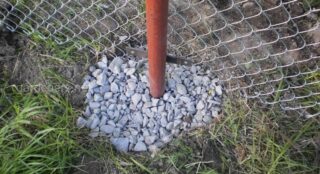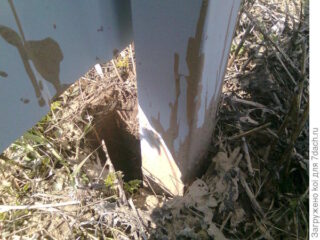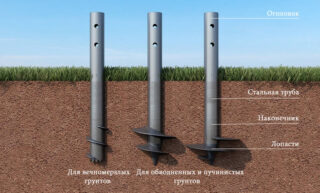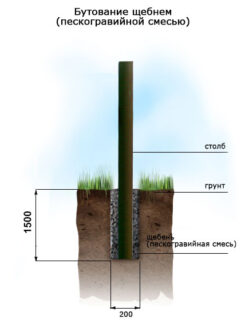The strength of the fence depends on the correct installation of the posts. The known method of installation is concrete, but it is not always justified. This method is not suitable for wooden poles, moving soil and high water tables. It is recommended to consider the technology of installing fence posts without concreting.
Support element types

When installing the fence, the owner needs to decide on the type of materials for the manufacture of the support. The quality of these elements affects the strength and stability of the fence. The materials for the pillars can be:
- brick or stone;
- wood;
- metal, including corrugated board and netting;
- pipes.
The cost and quality of the future fencing depends on the diameter of the supports. The fence has an average height of 1.8-2 meters. For spans made of wood, pillars of a similar material with a cross section of 15x15 or 20x20 cm are used. Reinforcement of the structure will be given by metal or shaped pipes. For round elements choose Ø 60-80 mm.
The peculiarity of the fence made of profile metal and other light materials is a high degree of windage. Pillars Ø100-120 mm will help to give stability to the fence. It is allowed to use pipes with a cross section of 60-80 mm, but with short spans. However, this approach requires high financial investments.
The optimal distance between the elements of the fence, installed without concreting, is 2 meters. Adhering to this step, the design will turn out to be reliable. The average height parameter of 1.9 m assumes the presence of two logs per section.
How to choose the type of installation of supports
Methods for installing fence posts without concreting:
- Shooting is a simple method involving filling the holes with sand or fine crushed stone.
- Driving into the soil is a time consuming but economical process.
- Prefabricated structures - hollow concrete blocks. Outside, the product can be embossed or smooth. Elements are installed one on top of the other, followed by pouring or backfilling with rubble.
- Screw piles are hollow pipes fitted with a blade at one end. When immersed, the element is screwed into the ground. Installation is simple, does not require specific equipment and skills.
The following factors also influence the choice of the method for installing the poles:
- the weight of the proposed structure;
- sailing;
- soil nuances, including moisture level;
- budget estimates.
The presence of non-porous soil allows you to install supports for the fence without concreting. It is enough to form the holes and fix the pillars in them. Then the soil is filled up and compacted to avoid soil subsidence.
The procedure for strengthening a previously installed fence

The restoration of a previously erected fence is carried out in several ways. The most common method is the compaction of soil around the supports or the addition of gravel. If the fence requires large-scale work, a bundle is carried out with a strip foundation.
In the absence of the need to use radical methods, it is enough to remove the rickety pillars. The pits are spilled with water and filled layer by layer with coarse crushed stone, followed by compaction. In rural settlements, jibs are used to straighten supports, but this option violates the aesthetic appeal. In order to avoid repairing the fence, it is necessary to adhere to the technology at the installation stage.
Pole installation technology using the butting method
- drilling rig (mechanical or electrical);
- spacers;
- building level;
- crushed stone of fine fraction.
Step-by-step instruction:
- Measurements and calculations. It is necessary to determine the size of the fence and the distance between the posts. Make a fence diagram and calculate how many supports and materials are needed for each section.
- Land plot markup. At this stage, you will need pegs, line or rope. Pull the thread around the perimeter of the fenced area and fix the wedges at the mounting points of the posts.
- Make a hole 1.5 meters deep, 20 cm wide and 20 cm longer than the support.
- Install the posts into the hole.
- Strengthen the support vertically with struts.
- Fill the hole with rubble mixed with sand.
- Tamp the base every 20 cm.
- Check the accuracy of the installation with a building level.
Supports made of wood or metal with a rectangular cross-section are installed so that the front surfaces are at the same level. Additional markup will make the work easier.
The nuances of installing pillars on heaving ground

To install a fence on heaving ground, contact the professionals, since this is a rather specific type of installation. Before starting work, it is necessary to pay attention to a number of factors on which the reliability of the future fence depends.
For fences made of lightweight materials, a careful calculation of the depth of immersion of the supports is required. It is possible to level the soil pressure on the pillars by digging in the elements below the freezing level. At this stage, you need to reduce the load as much as possible.
In relation to the European part of Russia, the standard depth parameters have been set - 1.2-1.5 m. The specialist will indicate the exact values after analyzing the soil. In the absence of knowledge in this area, it is better to immerse the supports to a level of 1.7 meters. It is recommended to sprinkle dry soil on the bottom of the pit - this will avoid the formation of a buoyancy force.
Before installing a fence on heaving ground, you should equip a drainage and water drainage system:
- Dig an inclined hole equal to the support depth.
- Lay the pipe wrapped in filter cloth.
- Cover the depression with gravel.
- To collect water, install a well or lead a pipe to a low part of the land.
To put a massive fence made of brick or stone, you need to build a foundation or concrete supports - this is how the maximum level of fastening is achieved. The first method assumes the following procedure:
- Dig a hole below the freezing point of the ground.
- Cover the bottom with crushed stone of the middle fraction - a layer of ~ 10 cm.
- Submerge the supporting elements.
- Fill the free space around the pillars with concrete.
Correct execution of instructions eliminates seasonal ground movement.
Concreting is a reliable method of installing fence posts. However, it may not be used in all cases. Correctly mounted supports without pouring a cement-sand mixture will not lose strength and will hold the fence for many years.











Hello! What do you advise when installing a fence in peat soil, how and what poles to install? Thanks in advance!
Igor, try googling the TISE piles. Suitable for difficult terrains.